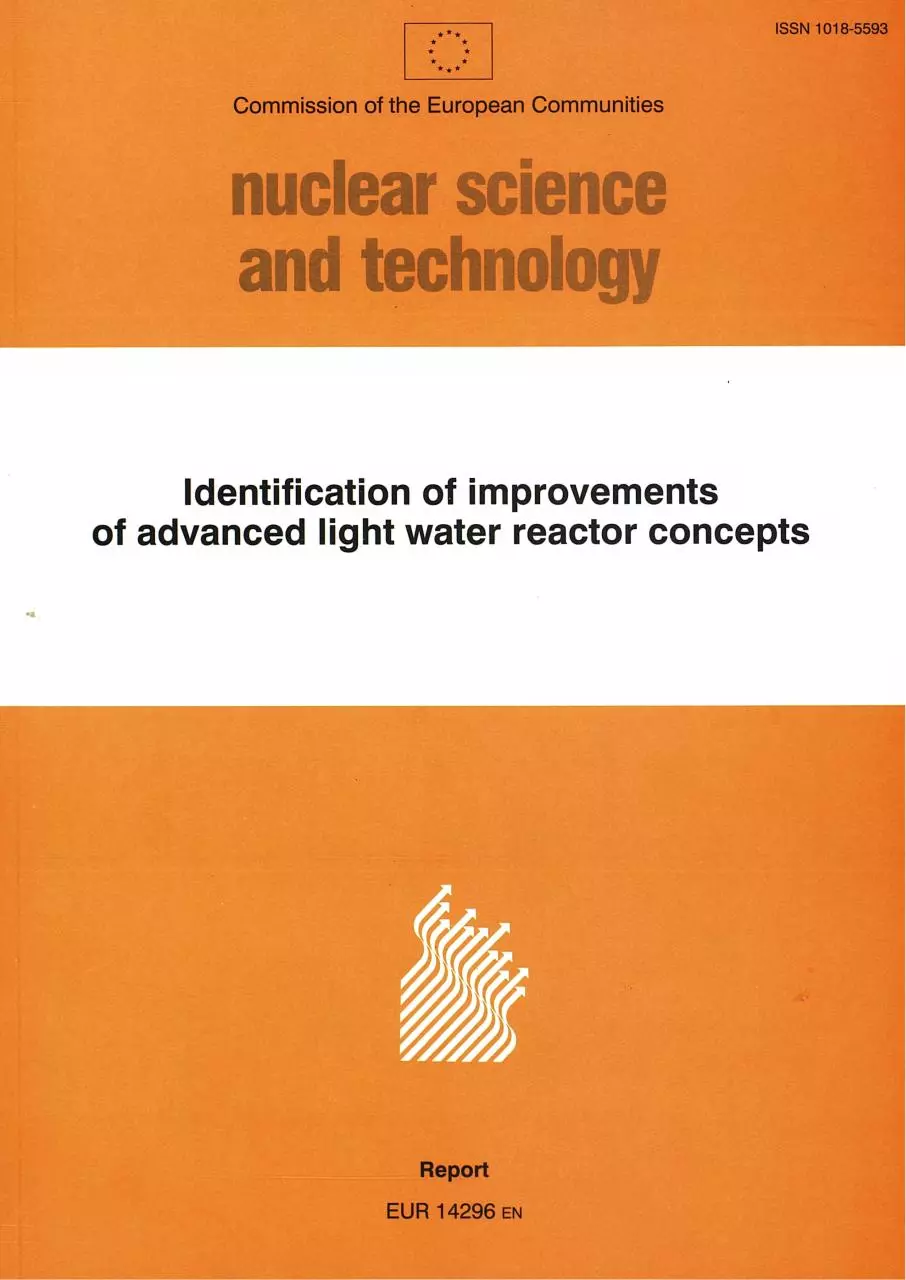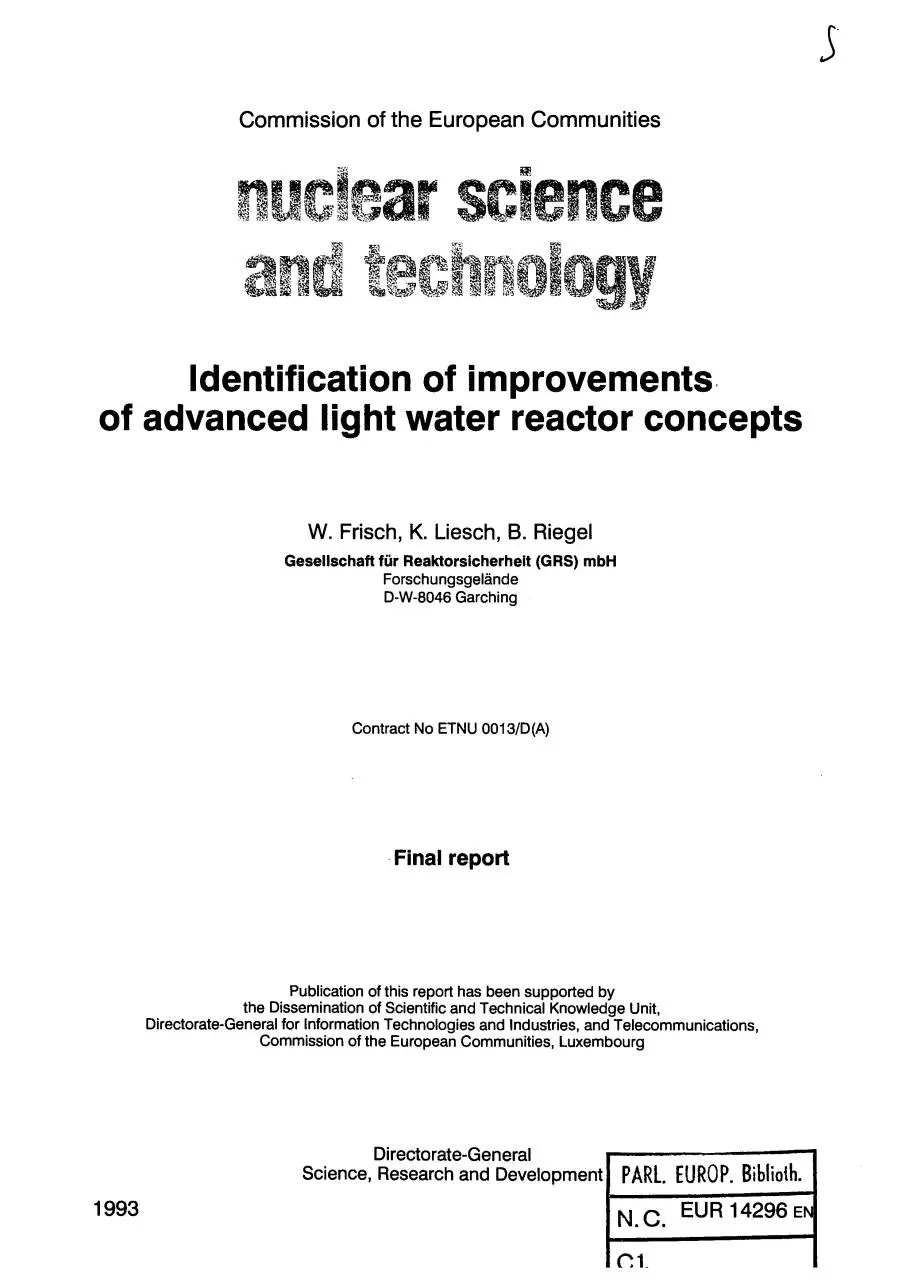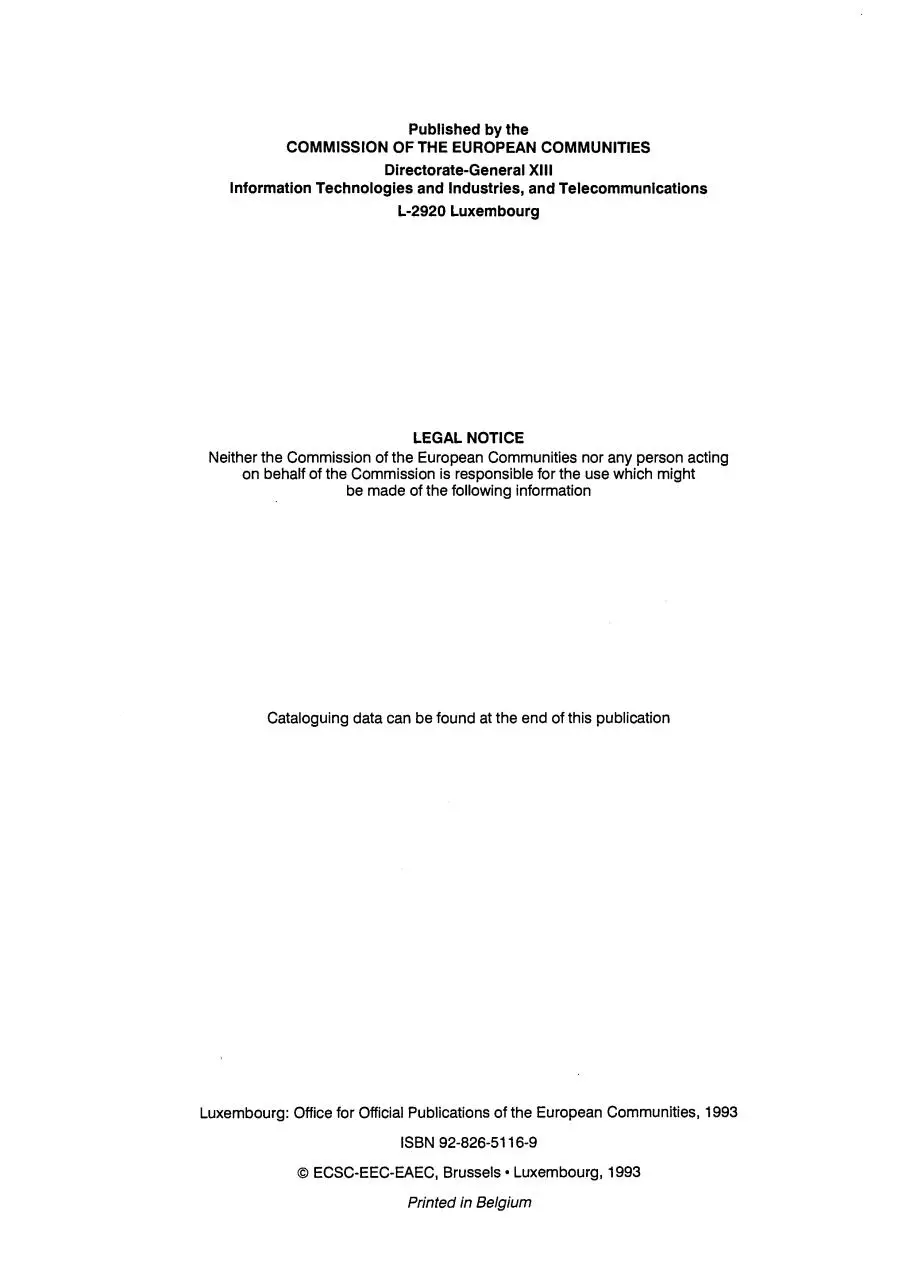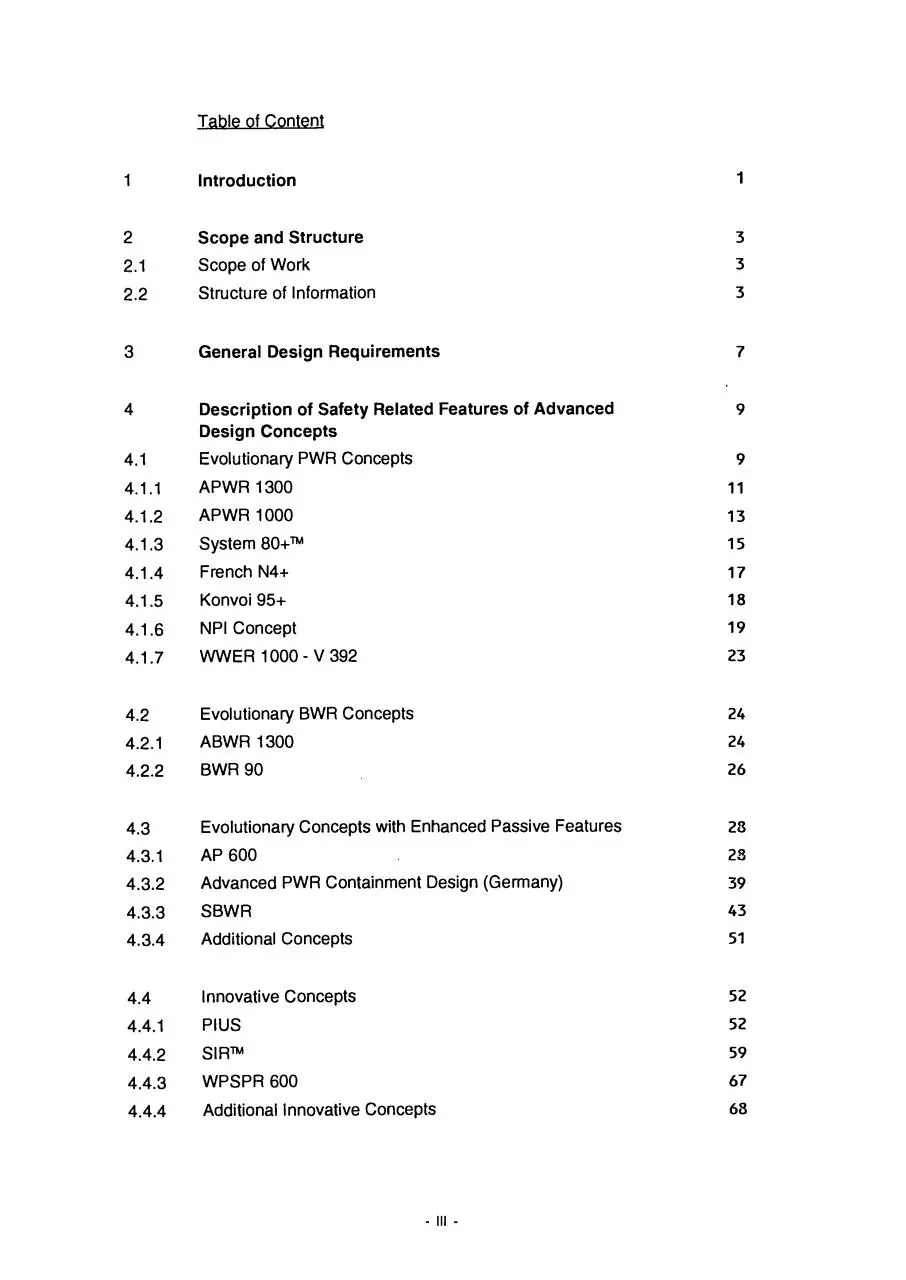CDNA14296ENC 001(1) (PDF)
File information
Title: Identification of improvements of advanced light water reactor concepts
Author: European Commission
This PDF 1.6 document has been generated by EUBookshop / Downgraded by EUDOR (PDFLibrary 8.1.0), and has been sent on pdf-archive.com on 08/12/2014 at 21:24, from IP address 217.5.x.x.
The current document download page has been viewed 864 times.
File size: 1.73 MB (100 pages).
Privacy: public file





File preview
ISSN 1018-5593
*"*
*
*
*
•
Commission of the European Communities
nuclear science
and technology
Identification of improvements
of advanced light water reactor concepts
S
Commission of the European Communities
nuclear science
i
s§v-is
Identification of improvements
of advanced light water reactor concepts
W. Frisch, K. Liesch, B. Riegel
Gesellschaft fur Reaktorsicherheit (GRS) mbH
Forschungsgelande
D-W-8046 Garching
Contract No ETNU 0013/D(A)
Final report
Publication of this report has been supported by
the Dissemination of Scientific and Technical Knowledge Unit,
Directorate-General for Information Technologies and Industries, and Telecommunications,
Commission of the European Communities, Luxembourg
Directorate-General
Science, Research and Development PARL EUROP. Bibliolh.
1993
N.C. EUR 14296 EN
CM
Published by the
COMMISSION OF THE EUROPEAN COMMUNITIES
Directorate-General XIII
Information Technologies and Industries, and Telecommunications
L-2920 Luxembourg
LEGAL NOTICE
Neither the Commission of the European Communities nor any person acting
on behalf of the Commission is responsible for the use which might
be made of the following information
Cataloguing data can be found at the end of this publication
Luxembourg: Office for Official Publications of the European Communities, 1993
ISBN 92-826-5116-9
© ECSC-EEC-EAEC, Brussels • Luxembourg, 1993
Printed in Belgium
Table of Content
1
Introduction
2
Scope and Structure
3
2.1
Scope of Work
3
2.2
Structure of Information
3
General Design Requirements
4
Description of Safety Related Features of Advanced
Design Concepts
9
4.1
Evolutionary PWR Concepts
9
4.1.1
APWR1300
11
4.1.2
APWR1000
13
4.1.3
System 80+™
15
4.1.4
French N4+
17
4.1.5
Konvoi 95+
18
4.1.6
NPI Concept
19
4.1.7
WWER 1000 - V 392
23
4.2
Evolutionary BWR Concepts
24
4.2.1
ABWR 1300
24
4.2.2
BWR 90
26
4.3
Evolutionary Concepts with Enhanced Passive Features
28
4.3.1
AP 600
28
4.3.2
Advanced PWR Containment Design (Germany)
39
4.3.3
SBWR
43
4.3.4
Additional Concepts
51
4.4
Innovative Concepts
52
4.4.1
PIUS
52
4.4.2
SIR™
59
4.4.3
WPSPR 600
67
4.4.4
Additional Innovative Concepts
68
Classification of Safety Related Design Features
69
Conclusion
79
Literature
81
IV
1
Introduction
Concerning the peaceful use of nuclear energy, the last two decades are characterized by a continuous effort to improve reactor safety. Various measures by authorities
and industry have contributed to a considerable reduction of the risk potential of nuclear power plants.
The experience gathered from plant operation and operational occurences, the knowledge gained from safety research and development activities and the deeper insight
into plant design obtained through probabilistic risk assessment studies, has led to numerous design improvement and backfitting measures in existing nuclear power
plants. This continuous process of safety improvement was accelerated after the TMI
accident. More in-depth-analyses and plant evaluations were performed, design deficiencies were searched for, numerous design improvements were implemented, and
severe accident research was started, however, the well proven safety philosophy had
not been changed significantly.
In recent years, in many countries a certain stillstand was observed in the utilisation of
nuclear energy, for various reasons (safety, economics, electricity demand, public acceptance). The accident of Chernobyl contributed significantly to this halt, but also to a
worldwide re-consideration of safety philosophy, though a direct transfer of the lessons learned to other plants is not possible because of the unique situation and design features of RBMK-reactors.
The periods of construction slow down and rethinking of the safety philosophy has
been utilized by many vendors to improve their design concepts or even develop entirely new concepts.
2
Scope and Structure
2.1
Scope of Work
The scope of this report is to identify the improvement of these reactor developments
with respect to reactor safety. This includes the collection of non-proprietary information on the description of the advanced design characteristics, especially summary design descriptions and general publications.
This documentation is not intended to include a safety evaluation of the advanced
concepts, however, it is structured in such a way that it can serve as a basis for a future safety evaluation. This is taken into account in the structure of the information regarding the distinction of the various concepts with respect to their "advancement"
and the classification of design characteristics according to some basic safety aspects
(see chapter 5). The overall description concentrates on those features which are relevant to safety. Other aspects, such as economy, operational features, maintenance,
construction period etc. are not considered explicitly in this report.
By far the largest number of advanced concepts belongs to the class of Light Water
Reactors (LWR). This report concentrates on this particular class of electric power generating reactors and does not include heavy water moderated reactors and gas and
liquid metal cooled reactors.
The content of this report is supposed to give an overview based on the most recent
publications available rather than an extended description of all details. However, it
has been tried to identify and collect the most detailed non-proprietary information on
the various concepts, therefore, the list of literature is recommended to readers who
want to study certain safety aspects in greater detail.
2.2
Structure of Information
When presenting material on "advanced" design features, the first task is to define the
reference situation or reference design to which the presented one is an advancement.
- 3
Download CDNA14296ENC 001(1)
CDNA14296ENC_001(1).pdf (PDF, 1.73 MB)
Download PDF
Share this file on social networks
Link to this page
Permanent link
Use the permanent link to the download page to share your document on Facebook, Twitter, LinkedIn, or directly with a contact by e-Mail, Messenger, Whatsapp, Line..
Short link
Use the short link to share your document on Twitter or by text message (SMS)
HTML Code
Copy the following HTML code to share your document on a Website or Blog
QR Code to this page

This file has been shared publicly by a user of PDF Archive.
Document ID: 0000198181.